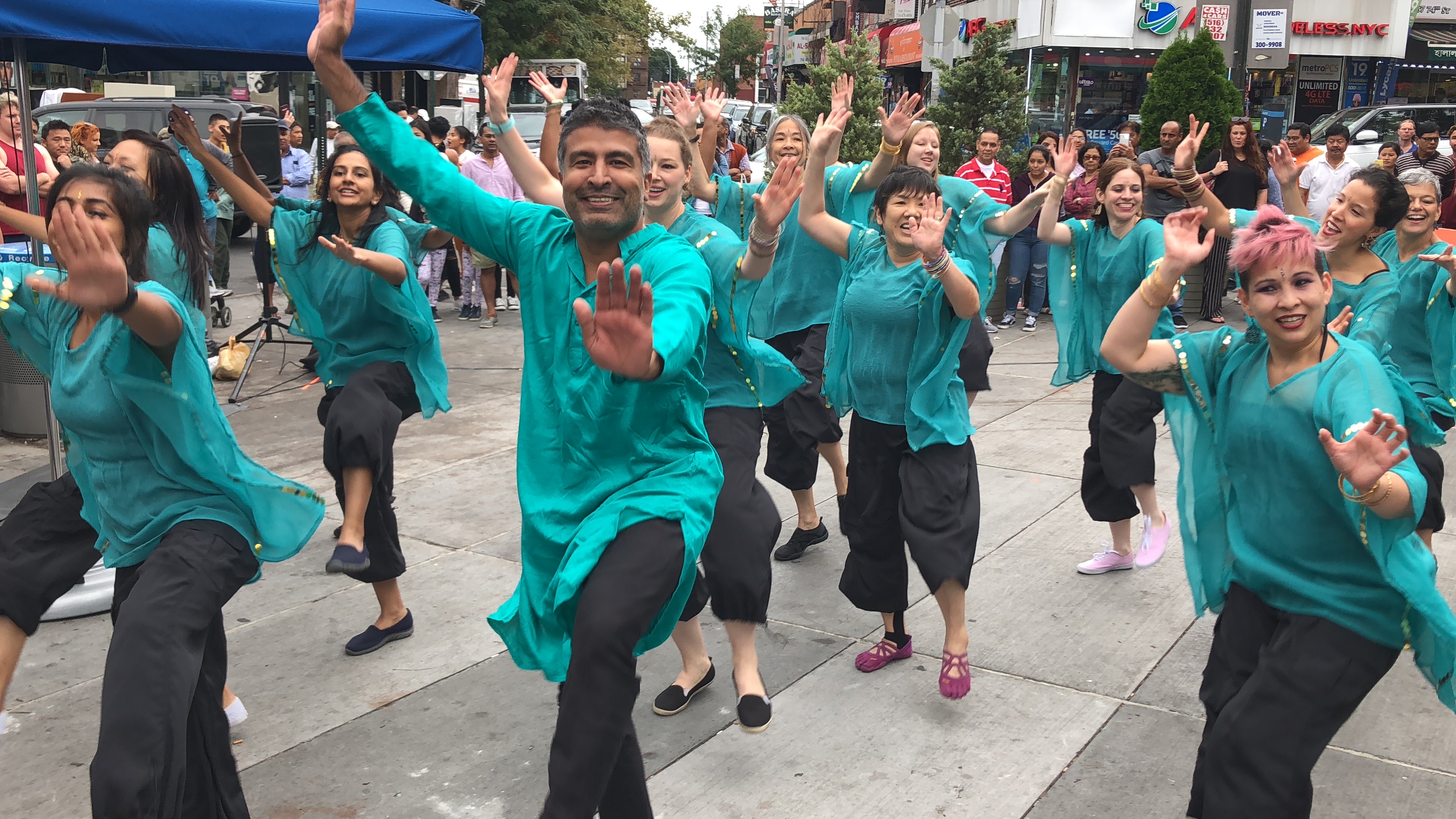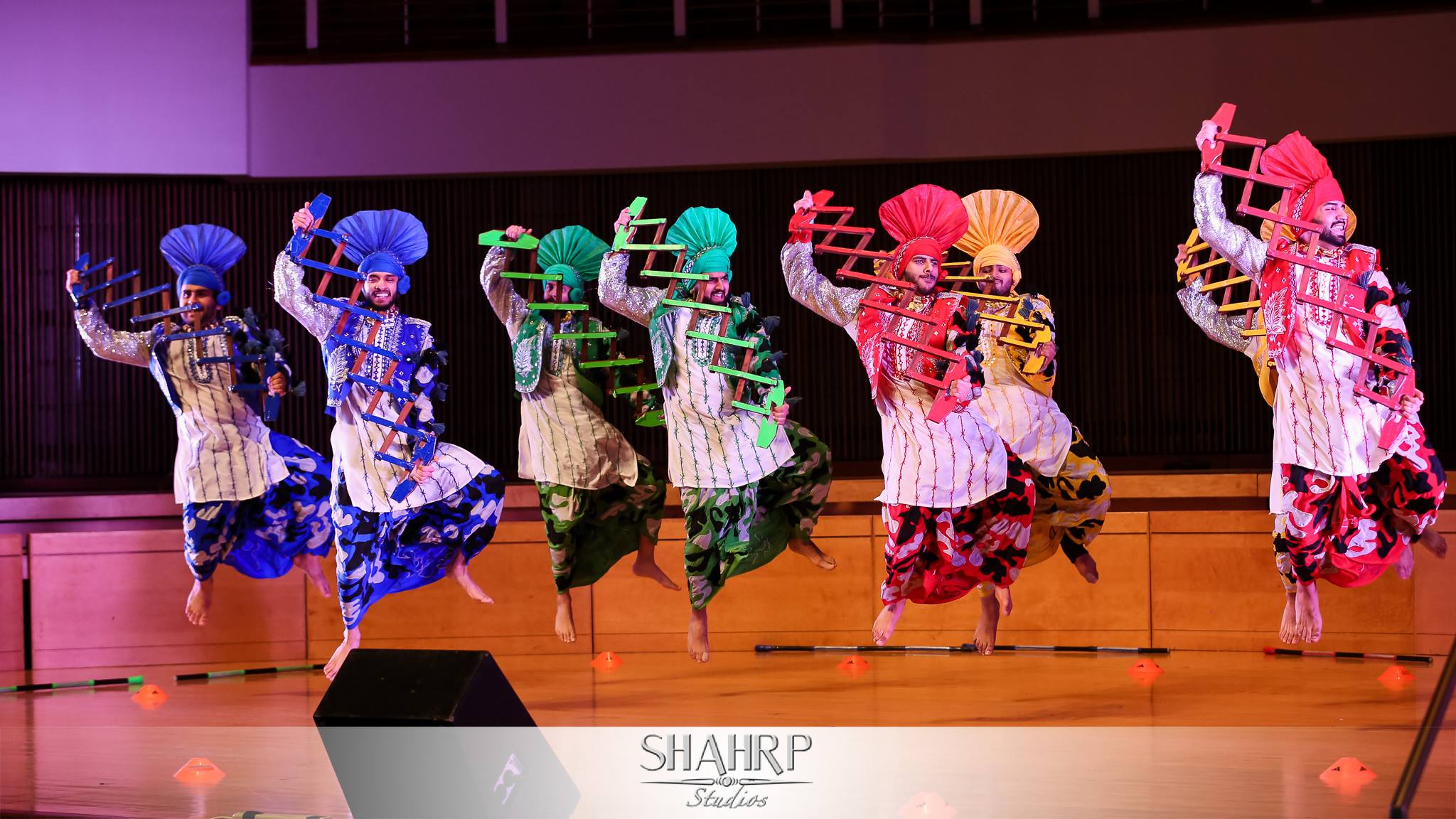In 2006, Sarina Jain – founder of Masala Bhangra Workouts – stood in front of an audience of 5,000 women in New York’s Central Park. She sported a plain T-shirt paired with colourful patiala pants and a bold bindi on her forehead. For the next 30 minutes, she shouted instructions and encouraging words to keep the audience going. “Put your index fingers in the air like you’re at my Indian wedding!” “Move your shoulders up and down like you don’t care.” At the end of the workout, she had the crowd chanting “balle balle” – a Punjabi phrase associated with everything joyous and delightful.
Sixteen years on, Masala Bhangra is now just one example of the ways in which bhangra – a traditional folk dance from Punjab, a region in northern India and Pakistan – continues to find a fan base in North America.
Videos by VICE

Bhangra started as a method of entertainment and celebration by Punjabi-Sikh farmers to observe Baisakhi (a harvest festival), honour their relationship with the land, and use dance to break the monotony of their day. Some of the traditional bhangra moves, such as the swaying of the arms from side to side, are representative of faslaan (crops) blowing in the wind and pay homage to daily farming activities.
The dance form travelled from the fields of Punjab to British, Canadian and American shores, courtesy of South Asian immigration in the late 1970s. This gave rise to artists like Indo-Canadian act Jazzy B or British-Indian Sukshinder Shinda, who have experimented with blending their cultures and identities through their music.
The Western world soon caught on. In the past few decades, bhangra has become a staple at Indian wedding receptions, gained popularity on Instagram and TikTok thanks to dance sensations like Manpreet Toor, and has been championed across hundreds of intercollegiate bhangra competitions.
It has even reached non-South Asian audiences through the fitness world – as represented by Masala Bhangra’s cardiovascular and conditioning classes – and in mainstream theatre productions like the new Bhangin’ It: A Bangin’ New Musical.
On American and Canadian college campuses, students utilise bhangra as a tool to socialise with their peers, examine their identity, and connect to their roots. One of the first groups to spearhead bhangra’s presence on college campuses was Bhangra Blowout in 1994 at the George Washington University in Washington D.C. What started off as an event for only 250 students to fundraise for a charity organisation eventually expanded into a regional, then national, and later global phenomenon.

“Over the years, we’ve succeeded in raising hundreds of thousands of dollars for various charities and have been integral in giving back to our local communities in need,” Gautam Gulati, co-founder of Bhangra Blowout, told VICE. “I saw these competitions as a global platform for up-and-coming artists to showcase their talent. While Bhangra Blowout is still ongoing, many other universities have started their own dance competitions.”
The present bhangra circuit also encompasses private instructors, non-collegiate teams and independent academies dancing on various platforms and inspiring the next generation of dancers – like this dancer on the snowy terrain of Yukon, Canada.
Teams such as the co-ed California-based Bhangra Empire have appeared at the 2018 NBA halftime show in their exuberant outfits (long, embroidered kurtas and heavy jewellery for women and pags or turbans for men), and even the White House for the Obamas’ first state dinner.

Apart from intercollegiate competitions, bhangra is visible in other industries, giving non-Indians an opportunity to learn about bhangra in a more inclusive manner.
Over her lengthy career, Jain has found Masala Bhangra to be an outlet of inclusivity, where anyone of any age, fitness level, or body type can learn about bhangra and dance along. Whether she is teaching at corporate events and schools around the country, or recording the original Masala Bhangra DVD series, the fusion of bhangra and fitness is meant to educate all. She even dresses to be approachable, consciously opting to teach her classes in a T-shirt paired with patiala pants as opposed to traditional Punjabi garb.
“We have evolved from a fitness program to a lifestyle where students have been coming to my class for the past 20 years,” Jain said. “I have retained the essence of bhangra and have taught it in a way that everyone can follow along.”
In addition to the fitness world, theatre is showcasing bhangra to a non-South Asian audience in a field that has only had a handful of South Asian musicals to date (most notably Bombay Dreams and Monsoon Wedding).
However, in March 2022, Bhangin’ It: A Bangin’ New Musical premiered in La Jolla Playhouse in California. It tells the story of a biracial student who finds community through dancing on her high school’s prestigious bhangra team. Partnering with Bhangra Empire and University of California San Diego’s collegiate dance team Da Real Punjabiz, the musical is the first of its kind to explore identity through bhangra.

“Bhangra has been incorporated in the show through traditional movements in the routine and by ensuring that cultural traditions and language are present throughout the script, staging and costuming,” said Anushka Pushpala, California-based bhangra specialist and associate choreographer for Bhangin’ It. “We show how to tie a pagh (turban) and traditional performance vardiyaan (clothing) such as chadars (loose loincloth tied around the dancer’s waist), vests, phumman (pom pom shoulder accessory), and chunnis (scarves).”
On one hand, the merging of East and West exemplifies representation and is an exciting way for non-South Asians to learn about the increasingly popular dance form. But on the other hand, there’s a fear that these adaptations may cost bhangra its original meaning.
Though the prevalence of bhangra globally is reflective of how marginalised immigrants have used music and dance to express their cultural knowledge, much has changed. Many routines no longer even use traditional Punjabi music, instead incorporating Western beats, music, and hybrid moves.
In fact, there is often a cross pollination of Bhangra and Bollywood, though conventionally the two genres and dancing techniques are wholly distinct from each other. Traditional instruments like the dhol and tumbis are often replaced with Western instruments like guitars and synthesizers. Routines now deviate from conventional dance formations and technique, and emphasise gimmicks and stunts. Even uniforms are increasingly influenced by Western clothing compared to traditional Bhangra garb.
Yet without all these, bhangra would have remained and languished in one corner of the world. Reaching new shores is helping ensure the art form’s survival, but the evolution it entails may render it unrecognizable to its progenitors.
Where, then, is the balance? How can bhangra grow without severing its Punjabi roots?
Professor Nalini Ghuman, an expert in musicology and ethnomusicology at Mills College in California, discusses the implication of the evolution as a folk dance to the fusion version it is today.
“Scholars have recently focused attention on how modern bhangra evolved in the scattering of peoples outside Panjab after the second migration of Panjabis to the West in the 1960s,” Ghuman told VICE, using the local name of the Punjab region. “Bhangra became a locus of identity formation for young, second generation South Asians growing up in the West, and it became an authentic expression of the two cultures which South Asian young people in the West find themselves caught between.”
Despite bhangra being a musical success story in its ability to attract the attention of the society at large, there is a fine line between assimilation and appropriation. Somewhere along the way, the line has become fuzzy.
“Bhangra can suffer from appropriation,” said Ghuman. “When I teach my university students about bhangra, we talk about how self-awareness is important as a person of non-Indian descent in performing, or learning an Indian folk dance/music. This means showing respect for its cultural heritage, and understanding its roots and routes, including the struggles of young South Asians growing up in the West.”
Similar to how there were concerns regarding cultural appropriation surrounding the practice of yoga, bhangra experts are concerned about the dramatic deviation from its original form, and they encourage precision of technique and ascribing dignity to its intended meaning.
“When bhangra is incorporated into mainstream society, what we see sometimes is not bhangra, but Bollywood,” said Harkiran Kullar, a bhangra dancer and former competition judge and coach from Vancouver, Canada. “For audiences that are non-Indian, it is difficult to differentiate between the two. The exposure needs to be accurate, so ensuring choreography, costumes, and music are dignifying bhangra during competitions and performances is ideal.”
To preserve the authenticity of bhangra, there should be a greater emphasis on education around the history of the dance form. Britain, a cultural centre for bhangra in the 80s and 90s, incorporated Bollywood and Bhangra as part of their school musical curriculum, a move that North American schools need to replicate. Without paying homage to bhangra’s roots, it will just become another element that gets mixed into the North American pot of culture.
Follow Pooja Shah on Instagram.




